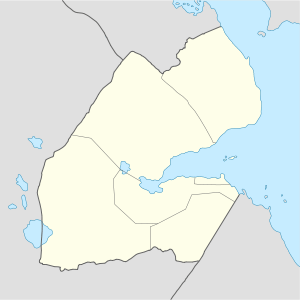Sagallo
| Sagallo | |
|---|---|
 | |
 Sagallo Location in Djibouti | |
| Coordinates: DJ 11°40′N 42°44′E / 11.667°N 42.733°E | |
| Country |
|
| Region | Tadjoura Region |
| Established | 6 January 1889 |
| Disbanded | 5 February 1889 |
| Founded by | Nikolay Ivanovitch Achinov |
| Elevation | 21 m (69 ft) |
Sagallo (Russian: Сагалло, French: Sagallou) was a short-lived Russian settlement established in 1889 on the Gulf of Tadjoura in present-day Djibouti.
Background
In 1883, Nikolay Ivanovitch Achinov (an adventurer, and burgess of Penza[1][2] b. 1856[3]) visited Abyssinia (Ethiopia) in order to establish clerical and political ties between the two countries. After his return to Russia, Achinov voiced his plans for a 1888 expedition to French Somaliland, while claiming to be a free cossack.
Achinov assured the participants that the sultan of Tadjoura, Mohammed Loitah, had permanently leased him land in the region.[4]
Arrival
On 10 December 1888, Achinov along with 165 Terek cossacks boarded Kornilov, a ship heading from Odessa to Alexandria. The expedition then boarded the Russian ship Lazarev which brought them to Port Said. There, Achinov rented the Austrian ship Amfitrida, which entered the gulf of Tadjoura on 6 January 1889. The expedition was greeted by a group of Ethiopean priests.[4]
Achinov struggled to keep the cossacks under his control, but some raided the Danakil, stealing a cow and a sheep after driving off the local tribesmen with rifle fire. The sultan accepted 60 francs from Achimov as reparations.[5] The French foreign office demanded an explanation of Achimov's actions, and the Russian ambassador in Paris distanced the Russian Empire from Achimov.
On January 14 the abandoned Egyptian fort of Sagallo was chosen as the new base of the expedition. Achinov named the fort New Moscow. A tent was erected to serve as the church of St. Nicholas and a flag of the expedition was raised.[4]
Destruction

Rumours about the formidable size of the expedition quickly spread through the press. Later, several colonists escaped to Obock, informing the French of the settlement's whereabouts. On 5 February, the cossacks noticed one cruiser and three gunboats. An ultimatum was issued, but Achinov misunderstood it and did not surrender. The artillery barrage that followed came as a complete surprise for the Russians, leaving 6 colonists dead and 22 wounded.[6] A white shirt was raised to show surrender. The Russian Government disavowed Achimov, accusing him of disobedience to the Czar and acts of piracy. Participants were arrested and deported back to Odessa aboard Zabiyaka.[5]
See also
References
Citations
- ↑ Ashinov, Achinov, Atchinoff or Atchimoff
- ↑ (French) Le cosaque Achinoff in Le Progrès Illustré (French daily newspaper), March 1, 1891
- ↑ Ernest A. Wallis Budge, A history of Ethiopia, Nubia and Abyssinia, Taylor & Francis,1928.
- 1 2 3 "Neva,2001, №8, p. 217-220". Retrieved 15 July 2014.
- 1 2 "French Somali History". Retrieved 15 July 2014.
- ↑ "Lunochkiv" (in Russian). Retrieved 16 July 2014.
Further reading
 "Sagallo". Encyclopædia Britannica. 23 (11th ed.). 1911.
"Sagallo". Encyclopædia Britannica. 23 (11th ed.). 1911.- Harding, Les. Dead Countries of the Nineteenth and Twentieth Centuries. The Scarecrow Press, 1998.
- Jean Robert Constantin (comte de), L'archimandrite Païsi et l'ataman Achinoff: une expédition religieuse en Abyssinie. Librairie de la Nouvelle Revue, 1891.
- French Somali Coast 1708 - 1946 (see 1889)
Coordinates: 11°40′13″N 42°44′00″E / 11.67028°N 42.73333°E